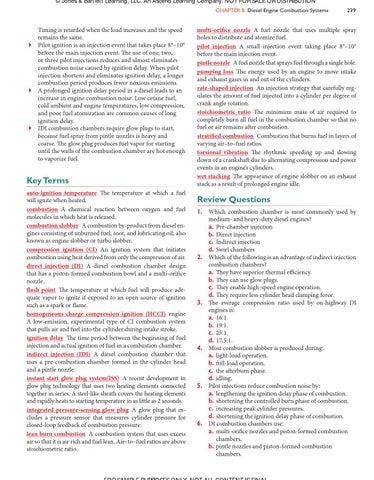© Jones & Bartlett Learning, LLC. An Ascend Learning Company. NOT FOR SALE OR DISTRIBUTION CHAPTER 8 Diesel Engine Combustion Systems
Timing is retarded when the load increases and the speed remains the same. Pilot ignition is an injection event that takes place 8°–10° before the main injection event. The use of one, two, or three pilot injections reduces and almost eliminates combustion noise caused by ignition delay. When pilot injection shortens and eliminates ignition delay, a longer combustion period produces fewer noxious emissions. A prolonged ignition delay period in a diesel leads to an increase in engine combustion noise. Low cetane fuel, cold ambient and engine temperatures, low compression, and poor fuel atomization are common causes of long ignition delay. IDI combustion chambers require glow plugs to start, because fuel spray from pintle nozzles is heavy and coarse. The glow plug produces fuel vapor for starting until the walls of the combustion chamber are hot enough to vaporize fuel.
Key Terms auto-ignition temperature The temperature at which a fuel will ignite when heated. combustion A chemical reaction between oxygen and fuel molecules in which heat is released. combustion slobber A combustion by-product from diesel engines consisting of unburned fuel, soot, and lubricating oil; also known as engine slobber or turbo slobber. compression ignition (CI) An ignition system that initiates combustion using heat derived from only the compression of air. direct injection (DI) A diesel combustion chamber design that has a piston-formed combustion bowl and a multi-orifice nozzle. flash point The temperature at which fuel will produce adequate vapor to ignite if exposed to an open source of ignition such as a spark or flame. homogeneous charge compression ignition (HCCI) engine A low-emission, experimental type of CI combustion system that pulls air and fuel into the cylinder during intake stroke. ignition delay The time period between the beginning of fuel injection and actual ignition of fuel in a combustion chamber. indirect injection (IDI) A diesel combustion chamber that uses a pre-combustion chamber formed in the cylinder head and a pintle nozzle. instant start glow plug system(ISS) A recent development in glow plug technology that uses two heating elements connected together in series. A steel-like sheath covers the heating elements and rapidly heats to starting temperature in as little as 2 seconds. integrated pressure-sensing glow plug A glow plug that includes a pressure sensor that measures cylinder pressure for closed-loop feedback of combustion pressure. lean burn combustion A combustion system that uses excess air so that it is air rich and fuel lean. Air–to–fuel ratios are above stoichiometric ratio.
239
multi-orifice nozzle A fuel nozzle that uses multiple spray holes to distribute and atomize fuel. pilot injection A small injection event taking place 8°–10° before the main injection event. pintle nozzle A fuel nozzle that sprays fuel through a single hole. pumping loss The energy used by an engine to move intake and exhaust gases in and out of the cylinders. rate-shaped injection An injection strategy that carefully regulates the amount of fuel injected into a cylinder per degree of crank angle rotation. stoichiometric ratio The minimum mass of air required to completely burn all fuel in the combustion chamber so that no fuel or air remains after combustion. stratified combustion Combustion that burns fuel in layers of varying air–to–fuel ratios. torsional vibration The rhythmic speeding up and slowing down of a crankshaft due to alternating compression and power events in an engine’s cylinders. wet stacking The appearance of engine slobber on an exhaust stack as a result of prolonged engine idle.
Review Questions 1. Which combustion chamber is most commonly used by medium- and heavy-duty diesel engines? a. Pre-chamber injection b. Direct injection c. Indirect injection d. Swirl chambers 2. Which of the following is an advantage of indirect injection combustion chambers? a. They have superior thermal efficiency. b. They can use glow plugs. c. They enable high-speed engine operation. d. They require less cylinder head clamping force. 3. The average compression ratio used by on-highway DI engines is: a. 16:1. b. 19:1. c. 25:1. d. 17.5:1. 4. Most combustion slobber is produced during: a. light-load operation. b. full-load operation. c. the afterburn phase. d. idling. 5. Pilot injections reduce combustion noise by: a. lengthening the ignition delay phase of combustion. b. shortening the controlled burn phase of combustion. c. increasing peak cylinder pressures. d. shortening the ignition delay phase of combustion. 6. DI combustion chambers use: a. multi-orifice nozzles and piston-formed combustion chambers. b. pintle nozzles and piston-formed combustion chambers.
FOR SAMPLE PURPOSES ONLY. NOT ALL CONTENT IS FINAL 9781449624118_CH08_Pass02.indd 239
06/10/15 7:54 PM
